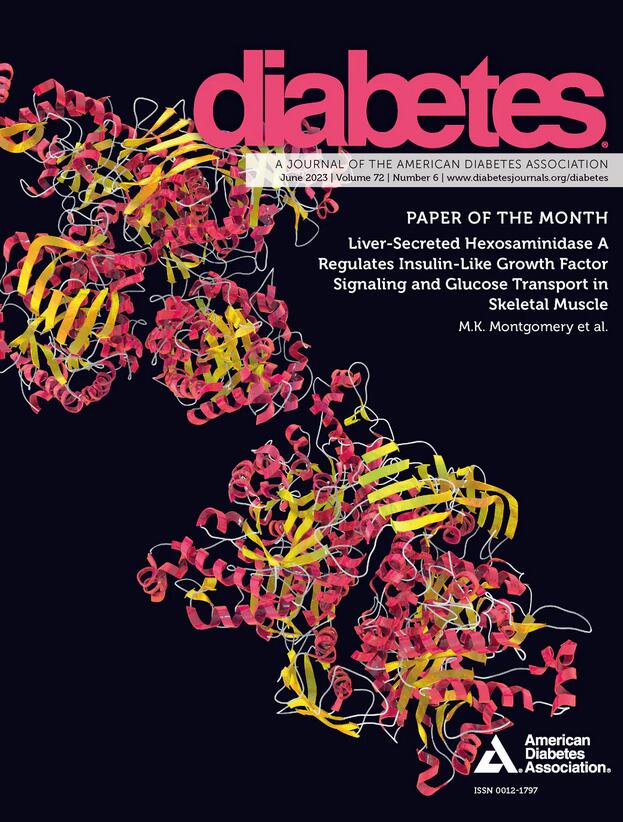恩格列净提高肝脏葡萄糖生成并降低全身去甲肾上腺素周转率:一项随机试验
IF 7.5
1区 医学
Q1 ENDOCRINOLOGY & METABOLISM
引用次数: 0
摘要
目前的研究检测了恩格列净对2型糖尿病(T2D)患者和非2型糖尿病患者肝葡萄糖生成(HGP)和全身去甲肾上腺素(NE)转化的影响。该研究随机选择36名T2D患者和36名非T2D患者,以双盲方式接受恩帕列净或匹配的安慰剂(2:1比例),为期12周。在基线和开始使用恩格列净或安慰剂治疗后第1天和第12周,分别用[3-3H]葡萄糖和[3H]NE输注来测量HGP和NE的转换。恩帕列净使T2D患者的HGP升高22%,无T2D患者的HGP升高19%,并且HGP升高持续到第12周。在给予恩格列净1天后,两组的全身NE周转率均显著下降,且NE周转率持续下降12周。NE周转率的降低与第12周HGP的升高呈显著负相关(r = 0.64, P <;0.001),但与给药第1天HGP升高无关(r = 0.09, P = ns)。这些结果表明,恩格列净导致NE周转的长期减少,并且NE周转的减少与HGP的增加密切相关。钠-葡萄糖共转运蛋白2抑制剂(SGLT2i)对交感神经活动的调节可以解释SGLT2i的一些全身作用,但不能解释SGLT2i诱导的长期HGP升高。钠-葡萄糖共转运蛋白2抑制剂(SGLT2i)导致肝糖生成(HGP)增加。我们之前的研究表明,SGLT2i导致全身去甲肾上腺素(NE)周转率迅速(在4小时内)增加,这可以解释HGP的增加。由于SGLT2i引起的HGP增加是持久的,因此我们研究了SGLT2i对NE周转率的长期影响。在开始治疗后的第1天和第12周,尽管葡萄糖产量增加,但恩帕列净引起的全身NE周转量下降,NE周转量下降的幅度与恩帕列净引起的HGP升高呈负相关。本文章由计算机程序翻译,如有差异,请以英文原文为准。
Empagliflozin Enhances Hepatic Glucose Production and Reduces Total-Body Norepinephrine Turnover Rate: A Randomized Trial
The current study examined the effect of empagliflozin on hepatic glucose production (HGP) and total-body norepinephrine (NE) turnover in individuals with and without type 2 diabetes (T2D). The study randomized 36 individuals with T2D and 36 individuals without T2D to receive in a double-blind fashion empagliflozin or matching placebo (2:1 ratio) for 12 weeks. HGP and NE turnover were measured with [3-3H]glucose and [3H]NE infusion, respectively, at baseline and at day 1 and 12 weeks after starting therapy with empagliflozin or placebo. Empagliflozin increased HGP by 22% in individuals with T2D and by 19% in those without T2D, and the increase in HGP persisted at week 12. Total-body NE turnover significantly decreased in both groups at 1 day after empagliflozin administration, and the decrease in NE turnover persisted for 12 weeks. The decrease in NE turnover strongly and inversely correlated with the increase in HGP at week 12 (r = 0.64, P < 0.001), but not with the increase in HGP on day 1 of empagliflozin administration (r = 0.09, P = ns). These results demonstrate that empagliflozin causes a long-term reduction in NE turnover and that the decrease in NE turnover was strongly correlated with the increase in HGP. Regulation of sympathetic activity by sodium–glucose cotransporter 2 inhibitors (SGLT2i) can explain some of the systemic actions of SGLT2i, but cannot explain the long-term SGLT2i-induced rise in HGP. ARTICLE HIGHLIGHTS Sodium–glucose cotransporter 2 inhibitors (SGLT2i) cause an increase in hepatic glucose production (HGP). We previously showed that SGLT2i cause a rapid (within 4 hours) increase in the total-body norepinephrine (NE) turnover rate, which could explain the increase in HGP. Because the increase in HGP caused by SGLT2i is long-lasting, we examined the long-term effect of SGLT2i on the NE turnover rate. Empagliflozin caused a decrease in total-body NE turnover at 1 day and at 12 weeks after starting therapy, despite an increase in glucose production, and the magnitude of decrease in NE turnover inversely correlated with the increase in HGP caused by empagliflozin.
求助全文
通过发布文献求助,成功后即可免费获取论文全文。
去求助
来源期刊

Diabetes
医学-内分泌学与代谢
CiteScore
12.50
自引率
2.60%
发文量
1968
审稿时长
1 months
期刊介绍:
Diabetes is a scientific journal that publishes original research exploring the physiological and pathophysiological aspects of diabetes mellitus. We encourage submissions of manuscripts pertaining to laboratory, animal, or human research, covering a wide range of topics. Our primary focus is on investigative reports investigating various aspects such as the development and progression of diabetes, along with its associated complications. We also welcome studies delving into normal and pathological pancreatic islet function and intermediary metabolism, as well as exploring the mechanisms of drug and hormone action from a pharmacological perspective. Additionally, we encourage submissions that delve into the biochemical and molecular aspects of both normal and abnormal biological processes.
However, it is important to note that we do not publish studies relating to diabetes education or the application of accepted therapeutic and diagnostic approaches to patients with diabetes mellitus. Our aim is to provide a platform for research that contributes to advancing our understanding of the underlying mechanisms and processes of diabetes.
 求助内容:
求助内容: 应助结果提醒方式:
应助结果提醒方式:


